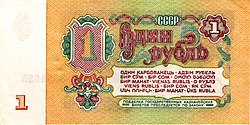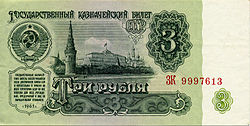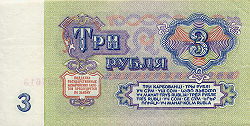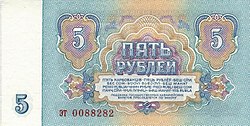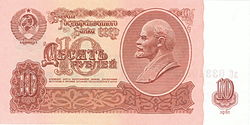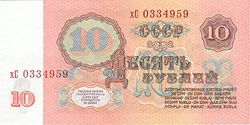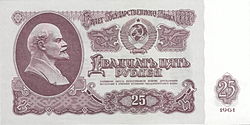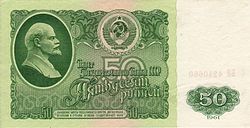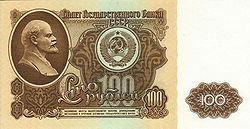The ruble or rouble (/ˈruːbəl/; Russian: рубль, romanized: rubl', IPA: [rublʲ]) was the currency of the Soviet Union. It was introduced in 1922 and replaced the Imperial Russian ruble. One ruble was divided into 100 kopecks (копейка, pl. копейки – kopeyka, kopeyki). Soviet banknotes and coins were produced by the Federal State Unitary Enterprise (or Goznak) in Moscow and Leningrad. In addition to regular cash rubles, other types of rubles were also issued, such as several forms of convertible ruble, transferable ruble, clearing ruble, Vneshtorgbank cheque, etc.; also, several forms of virtual rubles (called "cashless ruble", безналичный рубль) were used for inter-enterprise accounting and international settlement in the Comecon zone.[5] In 1991, after the dissolution of the Soviet Union, the Soviet ruble continued to be used in the post-Soviet states, forming a "ruble zone", until it was replaced with the Russian ruble in September 1993. The word ruble is derived from the Slavic verb рубить, rubit', i.e., 'to chop'. Historically, a "ruble" was a piece of a certain weight chopped off a silver ingot (grivna), hence the name. The word kopeck or copeck (in Russian: копейка kopeyka) is a diminutive form of the Russian kop'yo (копьё)—a spear. The reason for this is that a horseman armed with a spear was stamped on one of the faces of the coin. The first kopeck coins, minted at Novgorod and Pskov from about 1534 onwards, show a horseman with a spear. From the 1540s onwards the horseman bears a crown, and doubtless the intention was to represent Ivan the Terrible, who was Grand Prince of all Russia until 1547, and Tsar thereafter. Subsequent mintings of the coin, starting in the 18th century, bear instead Saint George striking down a serpent. Ruble in the Soviet Union The Soviet currency had its own name in all the languages of the Soviet Union, often different from its Russian designation. All banknotes had the currency name and their nominal printed in the languages of every Soviet Republic. This naming is preserved in modern Russia; for example: Tatar for 'ruble' and 'kopeck' are сум (sum) and тиен (tiyen). The current names of several currencies of Central Asia are simply the local names of the ruble. Finnish last appeared on 1947 banknotes since the Karelo-Finnish SSR was dissolved in 1956. The name of the currency in the languages of the fifteen republics, in the order they appeared in the banknotes:
Note that the scripts for Uzbek, Azerbaijani, Turkmen and gradually Kazakh have switched from Cyrillic to Latin since the breakup of the Soviet Union. Moldovan has switched to Latin and is once again referred to as Romanian. These fifteen names derive from four roots:
Sixth Soviet ruble, 1961–1991, (Identified as ISO code SUR) | ||||||||||||||||||||||||||||||||||||||||||||||||||||||||||||||||||||||||||||||||||||||||||||||||||||||||||||||||||||||||||||||||||||||||||||||||||||
|---|---|---|---|---|---|---|---|---|---|---|---|---|---|---|---|---|---|---|---|---|---|---|---|---|---|---|---|---|---|---|---|---|---|---|---|---|---|---|---|---|---|---|---|---|---|---|---|---|---|---|---|---|---|---|---|---|---|---|---|---|---|---|---|---|---|---|---|---|---|---|---|---|---|---|---|---|---|---|---|---|---|---|---|---|---|---|---|---|---|---|---|---|---|---|---|---|---|---|---|---|---|---|---|---|---|---|---|---|---|---|---|---|---|---|---|---|---|---|---|---|---|---|---|---|---|---|---|---|---|---|---|---|---|---|---|---|---|---|---|---|---|---|---|---|---|---|---|---|



